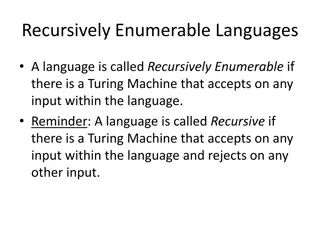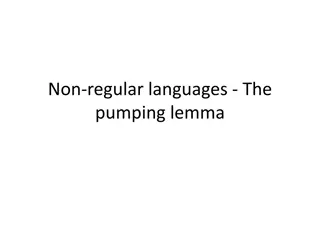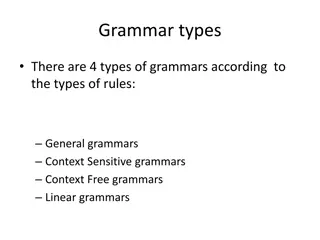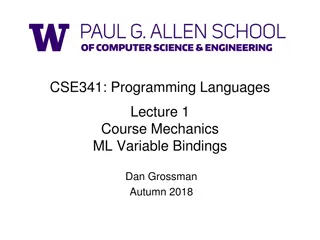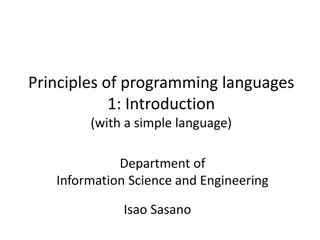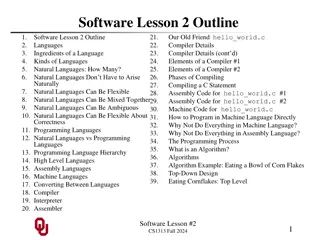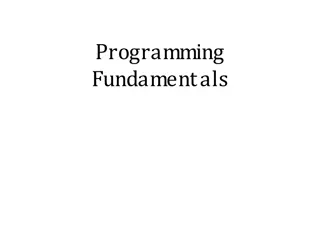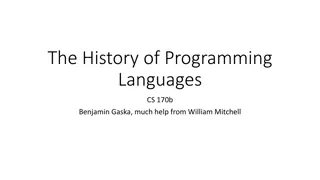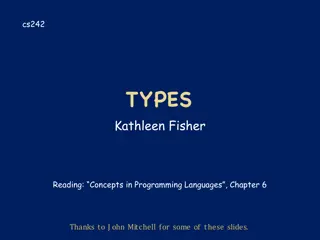Principles of Programming Languages at Vishnu Institute of Technology
Introduction to Principles of Programming Languages course including prerequisites, objectives, outcomes, and syllabus at Vishnu Institute of Technology. The course covers key concepts, popular programming paradigms and languages, practical knowledge in lexical analysis and parsing, as well as writing programs in different languages like C++, Java, Scheme, ML, and Prolog.
Download Presentation

Please find below an Image/Link to download the presentation.
The content on the website is provided AS IS for your information and personal use only. It may not be sold, licensed, or shared on other websites without obtaining consent from the author. Download presentation by click this link. If you encounter any issues during the download, it is possible that the publisher has removed the file from their server.
E N D
Presentation Transcript
Principles of Programming Languages P. S. Suryateja Asst. Professor, CSE Dept Vishnu Institute of Technology Vishnu Institute of technology Website: www.vishnu.edu.in
Introduction Vishnu Institute of technology Website: www.vishnu.edu.in
Course Prerequisites Sound math knowledge + Programming skills C Programming (CP) Object Oriented Programming through C++ (OOP C++) Object Oriented Programming through Java (OOP Java) Data Structures (DS) Engineering Mathematics (M-I, M-II) Mathematical Foundations of Computer Science (MFCS) Formal Languages and Automata Theory (FLAT) Vishnu Institute of technology Website: www.vishnu.edu.in
Course Objectives To learn the key concepts and to get a basic understanding of the most popular programming paradigms and languages, including their strengths and weaknesses and to learn writing small programs in different programming languages. Vishnu Institute of technology Website: www.vishnu.edu.in
Course Outcomes Ability to describe the syntax and semantics of programming languages and gain practical knowledge in lexical analysis and parsing phases of a compiler Ability to assess the merits and demerits of different constructs in programming languages Ability to design and implement sub programs in various programming languages Knowledge regarding different programming language features like object- orientation, concurrency, exception handling and event handling Knowledge regarding functional paradigm and ability to write small programs using Scheme and ML Knowledge regarding logic paradigm and ability to write small programs using Prolog Vishnu Institute of technology Website: www.vishnu.edu.in
Syllabus Unit 1: Syntax and Semantics Unit 2: Data, Data Types and Basic Statements Unit 3: Subprograms and its Implementation Unit 4: Object-Orientation, Concurrency, Event Handling Unit 5: Functional Programming Languages (Scheme, ML) Unit 6: Logic Programming Languages (Prolog) Vishnu Institute of technology Website: www.vishnu.edu.in
Text Books Concepts of Programming Languages Robert W. Sebesta Tenth Edition Programming Languages, Principles & Paradigms Allen B Tucker & Robert E Noonan Second Edition Vishnu Institute of technology Website: www.vishnu.edu.in
Web References Course URL: http://www.startertutorials.com/ppl/ Refer above URL for material, previous question papers and other useful links. Vishnu Institute of technology Website: www.vishnu.edu.in
Why Study Programming Languages? Increased capacity to express ideas Improved background for choosing appropriate language Increased ability to learn new languages Better understanding of the significance of implementation Better use of languages that are already known Overall advancement of computing Vishnu Institute of technology Website: www.vishnu.edu.in
Programming Domains Scientific Applications (Fortran) Business Applications (COBOL) Artificial Intelligence (LISP, Prolog) Systems Programming (C) Web Software (HTML, PHP, Java) Vishnu Institute of technology Website: www.vishnu.edu.in
Language Evaluation Criteria Readability Writability Reliability Cost Adopted from Concepts of Programming Languages - Sebesta Vishnu Institute of technology Website: www.vishnu.edu.in
Readability Overall simplicity Orthogonality Data Types Syntax Design Special words (while, if etc...) Form and meaning (Semantics should follow directly from the syntax. Ex: static has different meaning based on context in C) Vishnu Institute of technology Website: www.vishnu.edu.in
Readability Overall Simplicity A language with more number of basic constructs is more difficult to learn than one with a smaller number. Feature multiplicity (having more than one way to accomplish a particular operation). Ex: incrementing by 1 Operator overloading (ex: using + for adding arrays or difference b/w first elements in the arrays). Too much simplicity makes program less readable (ex: assembly language). Vishnu Institute of technology Website: www.vishnu.edu.in
Readability Orthogonality Orthogonality is the ability of combining a small set of primitives to build control and data structures. The more orthogonal the design of a language, more is the simplicity. Most orthogonal programming language is ALGOL 68. Functional languages offer potentially the greatest overall simplicity (as the same construct, a function can be used for all operations). Vishnu Institute of technology Website: www.vishnu.edu.in
Readability Orthogonality (cont...) IBM mainframe instructions for adding two integers that reside in main memory or registers: A reg1, memory_cell AR reg1, reg2 VAX minicomputer instruction: ADDL operand_1, operand_2 In the above example, VAX instruction is more orthogonal as it supports all four combinations with single instruction. Vishnu Institute of technology Website: www.vishnu.edu.in
Readability Data Types The presence of meaningful data types aids readability. If a numeric type is used to indicate Boolean conditions, the statement will be unclear. Ex: timeOut = 1 Vishnu Institute of technology Website: www.vishnu.edu.in
Writability Simplicity and Orthogonality A language with small set of primitives is better than one with a large set of primitives Too much orthogonality decreases writability Support for Abstraction Expressivity Vishnu Institute of technology Website: www.vishnu.edu.in
Writability Support for Abstraction Abstraction is the ability to define and use complicated structures or operations in ways that allow many of the details to be ignored. Programming languages can support two types of abstraction: process and data. Example for process abstraction is to use a subprogram for sorting that is required several times in a program. Example for data abstraction is a binary tree that stores integer data in its nodes. It is better to implement a binary tree in C++ or Java using classes rather than in Fortran77 using pointers and dynamic memory management. Vishnu Institute of technology Website: www.vishnu.edu.in
Writability Expressivity Ability of a language that allows a great deal of computation to be accomplished with a very small program. In C, count++ is more convenient than writing count = count + 1. Inclusion of for statement in Java makes writing counting loops easier than with the use of while. Vishnu Institute of technology Website: www.vishnu.edu.in
Reliability A program is said to be reliable if it performs to its specifications under all conditions. Type Checking Exception Handling Aliasing Readability and Writability Vishnu Institute of technology Website: www.vishnu.edu.in
Reliability Type Checking Type checking is simply testing for type errors either at compile time or run-time. As run-time type checking is expensive, compile time checking is desirable. (Ex: Java) Vishnu Institute of technology Website: www.vishnu.edu.in
Reliability Exception Handling Ability of a program to intercept run-time errors and take corrective measures is known as exception handling. Ada, C++, Java and C# provides extensive capabilities for exception handling. Vishnu Institute of technology Website: www.vishnu.edu.in
Reliability - Aliasing Aliasing is having two or more distinct names that can be used to access the same memory cell (Ex: Pointers in C and C++). Many languages greatly restrict aliasing to increase their reliability. Vishnu Institute of technology Website: www.vishnu.edu.in
Cost Total cost of a programming language is a function of: Cost of training the programmers Cost of writing the programs Cost of compiling the programs in the language Cost of executing programs Cost of language implementation system (Ex: JVM) Cost of poor reliability Cost of maintenance Other criteria that can be used to evaluate a programming language are: portability, generality and well-definedness. Vishnu Institute of technology Website: www.vishnu.edu.in
Influences on Language Design Computer Architecture Programming Design Methodologies Vishnu Institute of technology Website: www.vishnu.edu.in
Computer Architecture Imperative languages have been designed around the computer architecture called the von Neumann architecture. In this architecture, data and programs are stored in memory and they are executed by the CPU. Central features of imperative languages are variables, which model memory cells; assignment statements, which are based on the piping operation; and iterative form of repetition, which is the most efficient way to implement repetition on this architecture. Vishnu Institute of technology Website: www.vishnu.edu.in
Computer Architecture (cont...) Adopted from Concepts of Programming Languages - Sebesta Vishnu Institute of technology Website: www.vishnu.edu.in
Programming Design Methodologies Intense analysis begun in large part by the structured programming movement in the late 1960s. New software development methodologies that emerged as a result of the research in 1970s were called top-down design or stepwise refinement. In the late 1970s, a shift from procedure-oriented to data-oriented program design methodologies began. Vishnu Institute of technology Website: www.vishnu.edu.in
Programming Design Methodologies (cont...) First language to provide a limited support for data abstraction is SIMULA 67. Latest step in the evolution of data-oriented software development, which began in the early 1980s, is object-oriented design. First language to include object-oriented concepts was Smalltalk. Vishnu Institute of technology Website: www.vishnu.edu.in
Programming Design Methodologies (cont...) Imperative language like Ada 95, C++, Java and C# support object-orientation. Functional languages like CLOS and F# also support object-orientation. Logic programming language like Prolog++ supports object-orientation. Vishnu Institute of technology Website: www.vishnu.edu.in
Language Categories Imperative languages Object-oriented languages Functional languages Logical languages Visual languages Scripting languages Markup languages Vishnu Institute of technology Website: www.vishnu.edu.in
Language Design Trade-offs Reliability vs. Cost of Execution Ex: Arrays in Java are more reliable than in C (no bounds checking); whereas cost of execution of C arrays is less than that of Java. Readability vs. Writability Ex: APL provides rich set of operators for array operations. This allows to write a complex computation in less number of lines. But the readability of program decreases. (Daniel McCracken took four hours to read and understand a four-line APL program) Vishnu Institute of technology Website: www.vishnu.edu.in
Implementation Methods A language implementation system cannot be the only software on a computer. Requires an operating system also. The operating system and language implementations are layered over the machine language interface of a computer. Vishnu Institute of technology Website: www.vishnu.edu.in
Implementation Methods (cont...) Adopted from Concepts of Programming Languages - Sebesta Vishnu Institute of technology Website: www.vishnu.edu.in
Implementation Methods - Compilation Programs can be translated to machine language and be directly executed on the computer. This is called compiler implementation. Very fast program execution. Ex: C, C++, COBOL, Ada Vishnu Institute of technology Website: www.vishnu.edu.in
Implementation Methods Compilation (cont...) Adopted from Concepts of Programming Languages - Sebesta Vishnu Institute of technology Website: www.vishnu.edu.in
Implementation Methods Compilation (cont...) The user and system code together is called a load module or executable image. Process of collecting system programs and linking them to user programs is called linking and loading. This is done by a system program called as linker. The speed of connection between a computer s memory and its processor is known as von Neumann bottleneck. This is the primary motivation for research and development of parallel computers. Vishnu Institute of technology Website: www.vishnu.edu.in
Implementation Methods Pure Interpretation Programs are interpreted by another program called an interpreter, with no translation. Advantage is easy implementation of many source- level debugging operations. Disadvantage is this method is 10 to 100 times slower than compiled systems. Statement decoding is the bottleneck of a pure interpreter. Vishnu Institute of technology Website: www.vishnu.edu.in
Implementation Methods Pure Interpretation (cont...) Adopted from Concepts of Programming Languages - Sebesta Vishnu Institute of technology Website: www.vishnu.edu.in
Implementation Methods Pure Interpretation (cont...) Another disadvantage is, this method requires more space (for including symbol table along with source code). Ex: Earlier versions of APL, SNOBOL and LISP Vishnu Institute of technology Website: www.vishnu.edu.in
Implementation Methods Hybrid Approach Adopted from Concepts of Programming Languages - Sebesta Vishnu Institute of technology Website: www.vishnu.edu.in
Implementation Methods Hybrid Approach (cont...) High-level programs are translated to an intermediate language designed to allow easy interpretation. This method is better than pure interpretation as the source language statements are decoded only once. Ex: Perl, Java and .NET Vishnu Institute of technology Website: www.vishnu.edu.in
Programming Environments A programming environment is a collection of tools used in the development of software. UNIX is an older programming environment. GUI versions of UNIX or Solaris CDE, GNOME and KDE. Borland s JBuilder is an IDE. Microsoft s Visual Studio .NET NetBeans Vishnu Institute of technology Website: www.vishnu.edu.in








